Why does a gas stove give an electric shock: popular reasons and recommendations for eliminating them
It often happens that when you touch the body of a gas stove, a “tingling” sensation is felt.This is unpleasant, but the worst thing is that such minor troubles often develop into huge problems and breakdown of gas equipment. And no one needs such a development of the situation, right?
Therefore, when a gas stove shocks, it is necessary to immediately identify the cause and eliminate it. Moreover, this can be done quickly. How to detect the source of the problem and what to do in this case - we will consider all this in detail in our article.
The content of the article:
- Causes and methods of eliminating leakage currents
- Reason #1 - lack of grounding
- Reason #2 - violation of insulation integrity
- Reason #3 - oxidation of contacts
- Reason #4 - violation of the integrity of the wires
- Reason #5 - breakdown of the electric grill heating element
- Reason #6 - formation of a conductive “bridge”
- Reason #7 - problems with capacitors
- Reason #8 - influence of interference from other devices
- Reason #9 - socket malfunction
- If grounding is not provided?
- Conclusions and useful video on the topic
Causes and methods of eliminating leakage currents
Sometimes touching a gas stove causes discomfort due to the impact of small current discharges on the user. The power of which usually does not exceed 110 Volts, so they are not dangerous to life or even health.
But still, the presence of electricity on the body and other structural elements of the gas stove indicates that there is a malfunction. Moreover, it is dangerous because it is caused by current leakage.
Repairing equipment yourself is no less dangerous.Therefore, all you need to do if you find that your gas stove is giving you an electric current is to report the problem to the gas company you were with. service contract signed and provide the opportunity for the arriving master to perform his duties.
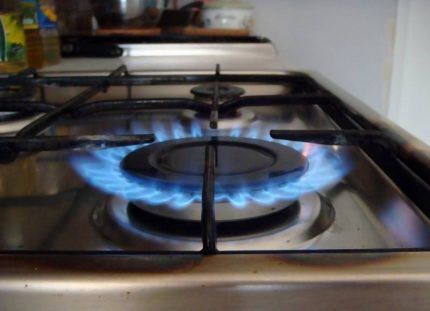
There are many reasons why a gas stove starts to shock:
- lack of grounding;
- violation of the integrity of wire insulation;
- oxidation of contacts;
- violation of the integrity of the wires;
- breakdown of the heating element, if the gas stove is equipped with an electric grill or oven;
- the formation of a conductive “bridge” due to the accumulation of third-party particles and liquids inside the slab;
- liquid entering contacts or other conductive elements of the gas stove. As a result, the circuit is closed on its body;
- problems with the capacitor;
- shielding;
- socket malfunction.
It is interesting that in the last two cases the slab is “hostage to the situation.” Since it is working properly, but its performance is reduced by third-party factors.
Since any of the listed reasons that cause electric shocks when using a gas cooking appliance are dangerous, it is worth taking a closer look at them.
Reason #1 - lack of grounding
The design of any modern gas stove is designed to eliminate the leakage of electrical energy. But tension on the casings of this equipment still often occurs.
And the main problem leading to electric shock of various voltages is lack of grounding. Which is a set of solutions to prevent the user from being harmed by an electric discharge. Moreover, no matter what it is: insignificant or deadly.
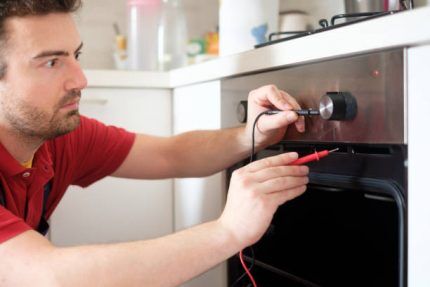
The situation is aggravated by the fact that most houses were built in Soviet times, and then there were no standards that would regulate the use of effective grounding systems for cases of current leakage. Therefore, the overwhelming number of users are not protected from its effects.
Today's new buildings are equipped with the necessary equipment. But the lack of a culture of use and low technical literacy lead to the fact that after just a few years, grounding in many buildings exists only on paper.
The reason is that users do not monitor the condition of protective devices, which as a result become inoperable due to the influence of a number of negative factors. Most often this is humidity, which quickly leads to oxidation of the terminals.
Often, problems with grounding are caused by incorrect design, when individual elements or its entire structure are exposed to high temperatures and intense ultraviolet radiation.
In both cases, over time, grounding becomes ineffective. This will not allow the required amount of electricity to be diverted from gas stoves and other household appliances at a critical moment.
How to identify a problem with a lack of grounding?
If the outlet where the gas stove is connected has only 2 wire outlets, this means that it is not grounded.This will be the reason why the user is exposed to current discharges.
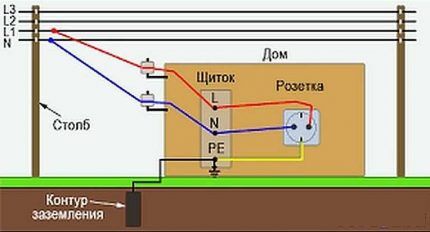
When the socket to which the device is connected “pinches” the fingers and other parts of the body with electric current, has 3 pins on the wires, then you should check grounding. What is done using a multimeter.
Restoring grounding functionality
If a grounding loop is provided, but has simply failed, then it is necessary to identify the cause and eliminate it so that the gas stove stops giving current.
Among the reasons the most popular are:
- terminal oxidation;
- damage to the ground loop structure.
In the first case, restoration of functionality is carried out by cleaning the terminals or replacing them.
If the structure is damaged, the faulty area or component is identified and the damage is repaired. The method of repair and the scope of work is determined individually in each specific case. For example, if the wires are broken, then they are connected or part of the wiring is replaced, which will prevent electric shocks when touching the body of the stove.
Reason #2 - violation of insulation integrity
Today, to increase functionality and ensure performance, the design of gas stoves is crammed with a large number of wires. The insulation of which is easily destroyed when exposed to high temperatures and mechanical loads.
Sometimes gas stoves are delivered with defective wires. In addition, insulation degrades during the aging process. All of the above become causes of malfunctions.The problem is resolved by replacing damaged wires.
To identify which methods are used:
- visual inspection;
- measuring resistance in individual areas.
In the latter case, you need to use a multimeter with a megohmmeter function. Before starting the “ringing” procedure, the stove must be de-energized.
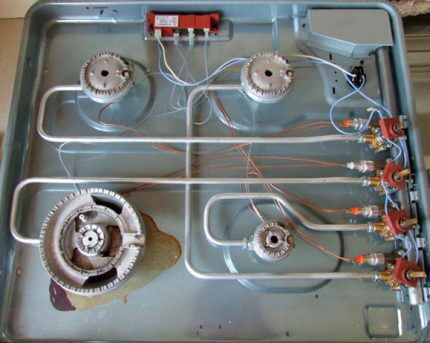
Despite the fact that the procedure for identifying a problem area and wire connections quite simple, you should understand that gas equipment is a source of increased danger, so even they should be entrusted to specialists.
Reason #3 - oxidation of contacts
Traditionally, problem areas in wiring are not isolated areas. The reasons are usually operation in difficult conditions. That is, elevated temperatures, their regular changes and even the usual overflow of liquids, which quite often happens when cooking, have an effect.
The methods for identifying and eliminating the fault are the same as in the case of violation of the integrity of the wire insulation. All features are described in the previous paragraph.
Reason #4 - violation of the integrity of the wires
Damage to such slab structural elements occurs under critical mechanical loads. And often this happens due to the fault of users. For example, when removing contaminants that have entered the inside of a gas stove. Or when trying to make adjustments or replace any parts (candles, temperature sensors).
A malfunction can often be identified visually. In other cases, you need to use a multimeter.
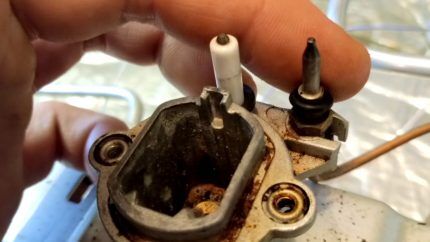
The best way to eliminate damage is replacement. That is, you should not take risks by connecting broken wires together.
Reason #5 - breakdown of the electric grill heating element
The presence of such a problem is often indicated by an unreasonable increase in the temperature of the housing or the electric heating element itself, even in the off position.
The problem can be resolved by replacing the problematic structural element. What should be entrusted to the master.
Reason #6 - formation of a conductive “bridge”
Most gas stove electrical appliances are located under the gas stove table and next to the burners. That is, they are not sufficiently protected from spilled liquids, fat, and food particles. Which leads to the formation of contaminants directly on the surfaces of autoignition spark plugs, temperature sensors, and wires. The situation is aggravated by dust and high temperatures, which can lead to melting and combustion of third-party particles.
All of the above makes the operating conditions of electrical equipment difficult and often leads to damage to the integrity of the wire insulation or other damage. And then the situation is further complicated by the fact that so-called conductive “bridges” are created, which lead to electric shocks of varying strengths.
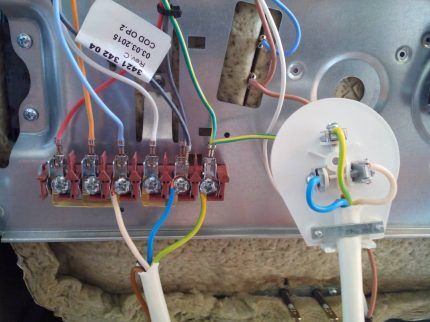
But often the electrical equipment remains in good working order. To check this, you need to clean the stove.
To do this you should do the following:
- Disconnect the gas stove.
- Remove the stove table.
- Clean electrical equipment. Namely temperature sensors, spark plugs, auto-ignition units, wiring. What they do with brushes and detergents.
- Measure the resistance of all electrical elements of the gas stove structure.
If there are no malfunctions, then operation of the gas appliance can continue. If a problem is identified, the faulty unit is replaced with a new one.
Reason #7 - problems with capacitors
Capacitors are used to smooth out impulse noise. And they are usually reliable. But, nevertheless, if the presence of more common causes of breakdowns has not been confirmed, and you have not found out why your gas stove is causing electric shock, then you should find a capacitor and check its functionality.
Faulty capacitors must be replaced.
Reason #8 - influence of interference from other devices
In this case, the gas stove is absolutely working. Nevertheless, users will regularly experience electric shocks.
The fact is that tension appears on the plate body interference from other electrical devices (washing machines, heated floors, etc.). Moreover, it may be that they are located in neighboring rooms or apartments.
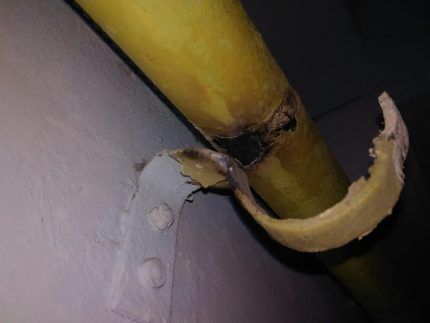
In simple cases, the malfunction can be corrected by the user himself. For example, sometimes this requires simply moving a nearby washing machine or using non-conducting stands or spacers. For example, installing them between a stove and a pipe or other equipment.
But in most cases, you cannot do without inviting a specialist.
Reason #9 - socket malfunction
Although the socket is not part of the stove, it is a common cause of the presence of current on the structural elements of the stove.
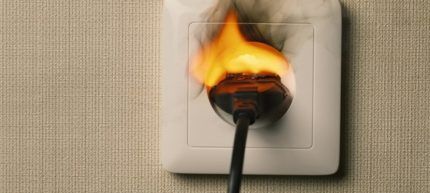
The functionality of sockets is affected by different types of loads, namely:
- mechanical;
- current
If in the first case the breakdown occurs quickly and usually its consequences are noticeable visually, then with critical current loads the problem can be hidden, and for a long time. Or have not clearly expressed signs in the form of minor discharges of electricity. But in the end it all ends in the breakdown of the gas stove, and sometimes in accidents.
That's why faulty socket must be replaced, and promptly.

After completion of work, it is necessary to perform a performance check.
All operations, without exception, must be performed by specialists. The reason is that most jobs require special knowledge and skills.
If grounding is not provided?
For a multi-storey building (residential, non-residential), developers usually create a single grounding loop.
Residents of houses in which grounding is not provided should approach solving problems in the same way. When all electrical appliances in the house are grounded, the optimal level of fire safety will be achieved.
And the creation of a single outline in a multi-story building will facilitate its official design. This is an important point, because grounding can be operated legally only after permission has been given.
To do this you need to perform a series of actions:
- Creating a project.
- Coordination of the project with Rostechnadzor and the company that supplies electricity.
- Creating a ground loop.
- Checking the functionality of the structure, which must be carried out by representatives of energy supervision authorities.
If the house is large and the total power consumption of electricity exceeds 100 kW, then when changing the design you will have to obtain an admission certificate.This document is unlimited and allows you to operate household electrical equipment.
Individual grounding for an apartment
Now let’s figure out what to do if the gas stove suddenly starts giving an electric shock, and the owners of other rooms in the house do not want to take care of safety. In this case, you can get out of the situation yourself. Why do you need to create individual grounding?
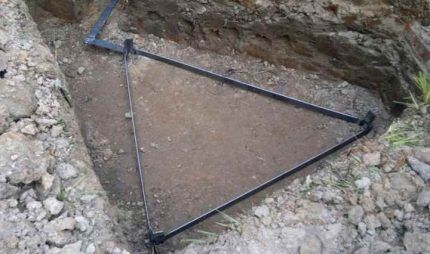
But it should be remembered that “partisan” actions cannot be taken. That is, a metal bucket buried under the window is not the right solution. Since this will violate the provisions of a number of documents: Chapter 1.7 PUE, which takes into account the requirements for grounding conductors, and, possibly, the terms of the agreement between the management company and the electricity supplier. Therefore, the procedure for creating grounding should begin with coordination.
If there are no obstacles from other interested parties, then a project should be created and approved by Rostechnadzor. And then you can start working.
Which, as in the case of a general circuit for the entire building, should end with the invitation of specialists from energy supervision authorities to carry out an inspection.
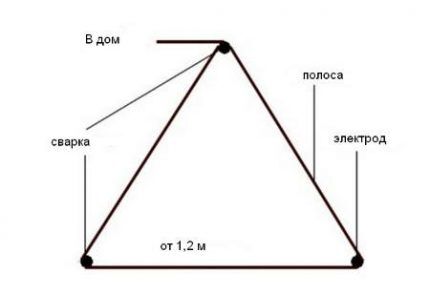
What the protective circuit should be like is stated in the PUE. Chapter 1.7 of which indicates that it is made from a number of required elements:
- Single-core PE conductor, which serves to remove electricity when it leaks. It is a copper or aluminum wire.
- Grounding bus. Such a device is usually placed on each floor of the building. The protective circuits of individual apartments and other premises are connected to the main bus.
- Electrodes and plates (made from metal conductive corners, pins) in the amount of 3 pieces. The pins are connected to each other by plates at an equal distance from each other. Then they are driven into the ground near the building.
All conductive parts of the structure must be insulated. This is done to prevent electric shock from direct or indirect contact.
If you live in a private house and not in an apartment, we recommend that you familiarize yourself with instructions for arrangement ground loop in the house.
Wires used to create protection against electrical leakage must have:
- cross-sectional area is the same as that of a phase wire with a cross-section of up to 16 mm²;
- cross-sectional area is not less than 16 mm², if the same figure for the phase wire is within 16-35 mm²;
- cross-sectional area is not less than half that of the phase wire.
That is, if voltage is supplied to a gas stove that generates current through a wire with a cross-section of 4 mm², then this indicates that grounding should be made from a 4 mm² wire.
How to replace the protective circuit?
A way out for residents of a house without grounding may be to connect an electric gas stove to RCD or difavtomat.
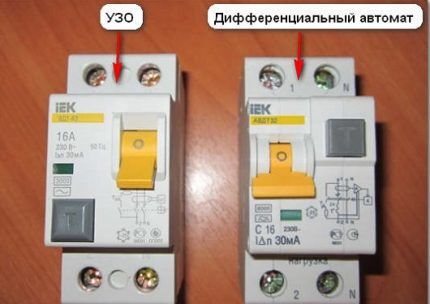
These devices are also protective devices that can protect the user from electric shock during a leak and maintain the functionality of the gas stove, like any other equipment.
But the peculiarity of the RCD is that it de-energizes an apartment or other room only when the leakage is dangerous. That is, this device will save life, health and maintain the functionality of all electrical appliances, but it will not allow you to avoid “pinching”.
We recommend that you familiarize yourself with the connection diagrams RCD And differential machine, and the order of work.
Conclusions and useful video on the topic
The first video contains information that will help you understand some of the causes of current leakage and understand how to deal with them:
The following video shows how you can independently detect the presence of a current leak:
The presence of a discharge on the body of the gas stove indicates that it is faulty or there are problems in the electrical network. The situation is complicated by the fact that “blue” fuel is flammable and explosive. That's why operation of the stove should be stopped immediately after the first signs of malfunction are identified. This will prevent accidents.
Your stove also recently experienced an electric shock, but did you successfully deal with this problem? Share your experience with other users, tell us what the problem was and how you managed to fix it - the comment form is located below this post.




There is not a word about the dielectric coupling on the gas pipe. But it was because of her that my house almost burned down. The metal eyeliner worked like a spiral. And the neighbors hung earth on the gas pipe.